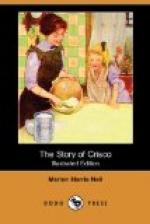Good cakes never can be made with indifferent materials. Eggs are used both as an aerating agent and as one of the “wetting” materials. It is not economy to buy cheap eggs, for such eggs are small, weak, colorless, and often very stale. Eggs should be well beaten, yolks and whites separately, unless other directions are given. The yolks must be beaten to a thick cream and the whites until they are a solid froth. Sugar tends to improve the texture of cakes, and when cheap cakes are made, plenty should be used, provided that the cake is not made too sweet. It should be dissolved before being added to the fat and the flour.
For best cakes, and all that are required of a light color, fine-grained sugar should be used. With coarse-grained sugar there is danger of producing specks which show on the cakes after baking, unless they have been made by the method of beating up the eggs and sugar together with a beater over hot water. This method will dissolve the grains of sugar.
Always buy the best fruits for cake making, as they are sweetest and cleanest. Currants and sultana raisins for cakes should not be too large, but of medium size, sweet and fleshy. Cheap dry sultanas should not be used. Though there is no need to wash sultanas, yet if the fruit is inclined to be very dry, it will be better to do so than to put them in to spoil the appearance and the flavor of the cake. Currants always should be washed, cleaned, and dried before using. Orange, lemon, and citron peel should be of good color and flavor. They should not be added to cake mixture in chunks, as often is done, but should be in long shredded pieces. Large pieces of peel are sometimes the cause of a cake cutting badly. In making fruit cakes add the fruit before the flour, as this will prevent it falling to the bottom.
If a cake cracks open while baking, the recipe contains too much flour. There are two kinds of thick crusts which some cakes have. The first of these is caused by the cake being overbaked in a very hot oven. Where this is so, the cake, if a very rich one, has a huge crack in the top caused by the heat of the oven forming a crust before the inside has finished aerating; then as the interior air or gas expands, it cracks the crust to escape. This crack spoils the appearance of the cake, and when cut it generally will be found to be close and heavy in texture. To guard against this it is necessary to bake them at a suitable temperature, noting that the richer the cake the longer the fruit takes to bake.
The second kind of thick crust referred to may only be on top of the cake, and in this case may be caused by an excess of fat and sugar being mixed together, or otherwise insufficient flour. In this case the mixture will not bake, but only forms a kind of syrup in the oven, and the cake sinks in the center. A cake made under such conditions would have a thick shiny crust, and be liable to crumble when touched. The inside of the cake would be heavy, having more the appearance of pudding than cake.




